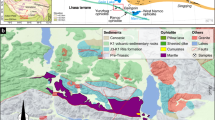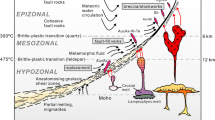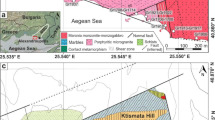Abstract
MORB suites display variations in their chemical differentiation trends which are closely related to the incompatible element enrichment of the basalts. We examine suites of primitive to evolved basalts from the Pacific-Nazca Ridge at 28° S (mostly depleted); from the Juan Fernandez microplate region (depleted) and from the Explorer Ridge, northeast Pacific (mostly enriched). Trends for incompatible element enriched MORBs consistently show less depletion of Al2O3 and less enrichment of FeO when plotted on MgO variation diagrams.
Least squares modeling indicates that enriched basalts have undergone less plagioclase crystallization than depleted basalts especially in the early stages of differentiation. Using thermodynamic modelling, we show that variations between MORB differentiation trends result largely from differences in the major element chemistry and H2O content of primary magmas. Our chosen enriched and depleted near-primary magmas are similar in major element chemistry but the enriched near-primary magma has higher H2O and lower Al2O3 than the depleted near-primary magma. The MORB crystallization sequence is: olivine→olivine+plagioclase → olivine+plagioclase+high-Ca pyroxene; and the separate and combined effects of lower Al2O3 and higher H2O are to cause plagioclase to crystallize later (lower temperature), and to make the interval of olivine+plagioclase crystallization shorter. As a result, enriched differentiates have higher Al2O3 and lower FeO than depleted MORBs at a given MgO content, even though their parents' Al2O3 is lower. Crystallization of enriched basalts at higher pressure than depleted basalts is not able to account for differences between the differentiation trends because the proportion of plagioclase is higher during three-phase crystallization at high pressure.
The variations in trends do not depend on geographic location and thus are superimposed on any regional variations in MORB chemistry or mantle source. Nor are they related to spreading rate. Depleted basalts from the fast-spreading 28° S and Juan Fernandez ridges have differentiation trends similar to depleted basalts from the medium-spreading Galapagos Spreading Center, whereas differentiation trends for enriched basalts from the medium-spreading Explorer Ridge are quite different. Fe3+/Fetotal is similar (and quite low) for enriched and depleted basalts, indicating that neither oxidation state nor early magnetite crystallization are important.
Similar content being viewed by others
References
Anderson-Fontana S, Engeln JF, Lundgren O, Larson RL, Stein S (1986) Tectonics and evolution of the Juan Fernandez Microplate at the Pacific-Nazca-Antarctic Triple Junction. J Geophys Res 91:2005–2018
Bence AE, Albee AL (1968) Empirical correction factors for the electron microanalysis of silicates and oxides. J Geol 76:382–403
Bender JF, Hodges FN, Bence AE (1978) Petrogenesis of basalts from the Project FAMOUS area: experimental study from 0 to 15 Kbars. Earth Planet Sci Lett 41:277–302
Bowen NL (1928) The evolution of the igneous rocks. Princeton University Press, Princeton NJ
Bryan WB (1983) Systematics of model phenocryst assemblages in submarine basalts: petrologic implications. Contrib Mineral Petrol 83:62–74
Bryan WB, Dick HJB (1982) Contrasted abyssal basalt liquidus trends: evidence for mantle major element heterogeneity. Earth Planet Sci Lett 58:15–26
Bryan WB, Moore JG (1977) Compositional variations of young basalts in the Mid-Atlantic Ridge rift valley near 36° 49′. Geol Soc Am Bull 88:556–570
Bryan WB, Thompson G, Michael PJ (1979) Compositional variation in a steady state zoned magma chamber: Mid-Atlantic Ridge at 36° 50′N. Tectonophysics 55:63–85
Byerly G (1980) The nature of differentiation trends in some volcanic rocks from the Galapagos Spreading Center. J Geophys Res 85:3797–3810
Byerly G, Melson WG, Vogt PR (1976) Rhyodacites, andesites ferrobasalts and ocean tholeiites from then Galapagos spreading Center. Earth Planet Sci Lett 30:215–221
Byers CD, Muenow DW, Garcia MO (1983) Volatiles in basalts and andesites from the Galapagos Spreading Center, 85° to 86° W. Geochim Cosmochim Acta 47:1551–1558
Byers CD, Christie DM, Muenow DW, Sinton JM (1984) Volatile contens and ferric-ferrous ratios of basalt, ferrobasalt, andesite and rhyodacite glasses from the Galapagos 95.5° W propagating rift. Geochim Cosmochim Acta 48:2239–2245
Carmichael ISE (1964) The petrology of Thingmuli, a Tertiary volcano in eastern Iceland. J Petrol 5:435–460
Christie DM, Sinton JM (1981) Evolution of abyssal lavas along propagating segments of the Galapagos spreading center. Earth Planet Sci Lett 56:321–335
Christie DM, Carmichael ISE, Langmuir ISE (1986) Oxidation states of mid-ocean ridge basalt glasses. Earth Planet Sci Lett 79:397–411
Clague DA, Bunch TE (1976) Formation of ferrobasalt at east Pacific mid-ocean ridge spreading centers. J Geophys Res 81:4247–4256
Clague DA, Frey FA, Thompson G, Rindge S (1981) Minor and Trace element geochemistry of volcanic rocks dredged from the Galapagos Spreading Center: role of crystal fractionation and mantle heterogeneity. J Geophys Res 86:9469–9482
Cousens BL, Chase RL, Schilling J-G (1984) Basalt geochemistry of the Explorer Ridge area, northeast Pacific Ocean. Can J Earth Sci 21:157–170
Craig H, Kim K-R, Francheteau J (1983) Active ridge crest mapping on the Juan Ferandez microplate: the use of Sea Beam-controlled hydrothermal plume surveys. Trans Am Geophys Union 64:856
Dixon Spulber S, Rutherford MJ (1983) The origin of rhyolite and plagiogranite in oceanic crust: an experimental study. J Petrol 24:1–25
Fenner CN (1931) The residual liquids of crystallizing magmas. Mineral Mag 22:539–560
Fisk MR, Bence AE, Schilling J-G (1982) Major element chemistry of Galapagos rift zone magmas and their phenocrysts. Earth Planet Sci Lett 61:171–189
Fornari DJ, Perfit MR, Malahoff A, Embley R (1983) Geochemical studies of abyssal lavas recovered DSRV Alvin from Eastern Galapagos Rift, Inca Transform and Ecuador Rift: 1. Major element variations in natural glasses and spacial distribution of lavas. J Geophys Res 88:10519–10529
Forsyth DW (1972) Mechanisms of earthquakes and plate motions in the East Pacific. Earth Planet Sci Lett 17:189–194
Fujii T, Bougault H (1983) Melting relations of a magnesian abyssal tholeiite and the origin of MORBs. Earth Planet Sci Lett 62:283–295
Fujii T, Kushiro I, Hamuro M (1978) Melting relations and viscosity of an olivine tholeiite. In: Melson WG, Rabinowitz PD, et al. (eds) DSDP Initial Rept, vol 45. US Govt. Printing Office, Washington, DC, pp 513–517
Ghiorso MS, Carmichael ISE (1980) A regular solution model for met-aluminous silicate liquids: applications to geothermometry, immiscibility, and the source regions of basic magmas. Contrib Mineral Petrol 71:323–342
Ghiorso MS, Carmichael ISE, Rivers ML, Sack RO (1983) The Gibbs free energy of mixing of natural silicate liquids; an expanded regular solution approximation for the calculation of magmatic intensive variables. Contrib Mineral Petrol 84:107–145
Grove TL, Baker MB (1984) Phase equilibrium controls on the tholeiitic versus calc-alkaline differentiation trends. J Geophys Res 89:3253–3274
Handschumacher DW (1976) Post-Eocene tectonics of the Eastern Pacific. In: Sutton G, Manghnani MH, Moberly R (eds) The geophysics of the Pacific Ocean Basin and its margin. Geophys Monogr Ser, vol 19, AGU, Washington, DC
Herron EM (1972) Two small crustal plates in the South Pacific near Easter Island. Nature Phys Sci 240:35–37
Hey RN, Naar DF, Kleinrock MC, Phipps-Morgan WJ, Morales E, Schilling J-G (1985) Microplate tectonics along a superfast seafloor spreading system near Easter Island. Nature 317:320–325
Jaques AL, Green DH (1980) Anhydrous melting of peridotite at 0–15 kb pressure and the genesis of tholeiitic basalts. Contrib Mineral Petrol 73:287–310
Jarosewich E, Nelen JA, Norberg JA (1980) Reference samples for electron microprobe analysis. Geostds Newslett 4:43–47
Klein EM, Langmuir CH (1987) Global correlations of ocean ridge basalt chemistry with axial depth and crustal thickness. J Geophys Res (in press)
Kushiro I (1972) Effect of water on the composition of magmas formed at high pressures. J Petrol 13:311–334
Kushiro I (1974) On the nature of silicate melt and its significance in magma genesis: regularities in the shift of the liquidus boundaries involving olivine, pyroxene and silica minerals. Am J Sci 275:411–431
MacDougall JD, Lugmair GW (1985) Extreme isotopic homogeneity among basalts from the southern East Pacific Rise: mantle or mixing effect? Nature 313:209–211
Malahoff A, Hammond SR, Embley RW, Currie RG, Davis EE, Riddihough RP, Sawyer BS (1985) Juan de Fuca Ridge Atlas: preliminary SEABEAM bathymetry. Geol Surv Can EMR Open File Rep 1144
McClain JS, Orcutt JA, Burnett M (1985) The East Pacific Rise in cross section: a seismic model. J Geophys Res 90:8627–8639
Melson WG, Vallier TL, Wright TL, Byerly GR, Nelen JA (1976) Chemical diversity of abyssal volcanic glass erupted along the Pacific, Atlantic and Indian Ocean sea-floor spreading centers. In: Sutton G, Manghnani MH, Moberly R (eds) The geophysics of the Pacific Ocean Basin and its margin. Geophys Monogr Ser, vol 19, AGU, Washington, DC, pp 351–367
Melson WG, Byerly GR, Nelen JA, O'Hearn T, Wright TL, Vallier TL (1977) A catalog of the major element chemistry of abyssal volcanic glasses. Smithson Contrib Earth Sci 19:31–60
Meyer PS, Sigurdsson H, Schilling J-G (1985) Petrological and geochemical variations along Iceland's neovolcanic zones. J Geophys Res 90:10043–10072
Michael PJ, Bonatti E (1985) Regional variations of peridotite composition in the North Atlantic: implications for partial melting. Earth Planet Sci Lett 73:91–104
Michael PJ, Chase RL, Shea GT, O'Hearn T (1985) Petrology and tectonics of Southern Explorer Ridge. Geol Soc Am 17:369
Miyashiro A (1974) Volcanic rock series in island arcs and active continental margins. Am J Sci 274:321–355
Moore JG (1970) Water content of basalt erupted on the ocean. Contrib Mineral Petrol 28:272–279
Moore JG, Batchelder JN, Cunningham CG (1977) CO2-filled vesicles in mid-ocean basalt. J Volcanol Geotherm Res 2:309–327
Morton JL, Sleep NH (1985) A mid-ocean ridge thermal model: constraints on the volume of axial hydrothermal heat flux. J Geophys Res 90:11345–11353
Naar DF, Hey RN (1986) Fast rift propagation along the East Pacific Rise near Easter Island. J Geophys Res 91:3425–3438
Nicholls J, Russell JK, Stout MZ (1986) Testing magmatic hypotheses with thermodynamic modelling. In: Scarfe CM (ed) Silicate melts: their properties and structure applied to problems in geochemistry, petrology, economic geology and planetary geology. Mineral Association of Canada, Ottawa, pp 210–235
Norrish K, Hutton JT (1969) An accurate X-ray spectrographic method for the analysis of a wide range geologic samples. Geochim Cosmochim Acta 33:431–453
O'Donnell TH, Presnall DC (1980) Chemical variations of the glass and mineral phases in basalts dredged from 25–30° N along the mid-Atlantic Ridge. Am J Sci 280-A:845–868
Perfit MR, Fornari DJ (1983) Geochemical studies of abyssal lavas recovered by DSRV Alvin from Eastern Galapagos Rift, Inca Transform and Ecuador Rift. 2. Phase chemistry and crystallization history. J Geophys Res 88:10530–10550
Presnall DC, Dixon SA, Dixon JR, O'Donnell TH, Brenner NL, Schrock RL, Dycus DW (1978) Liquidus phase reltions on the join Diopside-Forsterite-Anorthite from 1 atm to 20 kbar: their bearing on the generation and crystallization of basaltic magma. Contrib Mineral Petrol 66:203–220
Riddihough RP (1977) A model for recent plate interactions off Canada's west coast. Can J Earth Sci 14:384–396
Riddishough R (1984) Recent movements of the Juan de Fuca Plate system. J Geophys Res 89:6980–6994
Riddihough RP, Currie RG, Hyndman RD (1980) The Dellwood Knolls and their role in sstriple junction tectonics off northern Vancouver Island. Can J Earth Sci 17:577–593
Roeder PL, Emslie RF (1970) Olivine-liquid equilibrium. Contrib Mineral Petrol 29:275–289
Russell JK, Nicholls J (1985) Application of Duhem's Theorem to the estimation of extensive and intensive properties of basaltic magmas. Can Mineral 23:479–488
Schilling J-G, Zajac M, Evans R, Johnston T, White W, Devine JD, Kingsley R (1983) Petrologic and geochemical variations along the mid-Atlantic Ridge from 29° N to 73° N. Am J Sci 283:510–586
Schilling J-G, Sigurdsson H, Davis AN, Hey RN (1985) Easter microplate evolution. Nature 317:325–331
Scott SD, Barrett TJ, Hannington M, Chase RL, Fouquet Y, Juniper K (1984) Tectonic framework and sulfide deposits of the southern Explorer Ridge, northeastern Pacific Ocean. Trans Am Geophys Union 65:1111
Shea GT, Michael PJ, Chase RL (1985) Basalt geochemistry from the Magic Mountain hydrothermal region, southern Explorer Ridge. Trans Am Geophys Union 66:926
Sigurdsson H (1981) First-order major element variation in basalt glasses from the Mid-Atlantic Ridge, 29° N to 73° N. J Geophys Res 86:9483–9502
Sinton JM, Wilson DS, Christie DM, Hey RN, Delaney JR (1983) Petrologic consequences of rift propagation on oceanic spreading ridges. Earth Planet Sci Lett 62:193–207
Stakes DS, Shervais JW, Hopson CA (1984) The volcanic-tectonic cycle of the FAMOUS and AMAR valleys, Mid-Atlantic Ridge (36° 47′ N): Evidence from basalt glass and phenocryst compositional variations for a steady-state magma chamber beneath the valley midsections, AMAR 3. J Geophys Res 89:6995–7028
Stolper E (1980) A Phase diagram for mid-ocean ridge basalts: preliminary results and implications for petrogenesis. Contrib Mineral Petrol 74:13–27
Stout MZ, Nicholls J (1977) Mineralogy and petrology of Quarternary lavas from the Snake River Plain, Idaho. Can J Earth Sci 14:2140–2156
Takahashi E, Kushiro I (1983) Melting of a dry peridotite at high pressures and basalt magma genesis. Am Mineral 68:859–879
Verma SP, Schilling J-G (1982) Galapagos Hotspot-Spreading Center System. 87Sr/86Sr and large ion lithophile element variations (85° W–101° W) J Geophys Res 87:10838–10856
Wager CR, Deer WH (1939) The petrology of the Skaergaard Intrusion, Kangerlassuaq, East Greenland. Medd Groenl 105:352
Walker D, Shibata T, DeLong SE (1979) Abyssal tholeiites from the Oceanographer Fracture Zone II, phase equilibria and mixing. Contrib Mineral Petrol 70:111–115
Wilson AD (1960) The micro-determination of ferrous iron in silicate minerals by a volumetric and a colorimetric method. Analyst 85:823–827
Author information
Authors and Affiliations
Rights and permissions
About this article
Cite this article
Michael, P.J., Chase, R.L. The influence of primary magma composition, H2O and pressure on mid-ocean ridge basalt differentiation. Contr. Mineral. and Petrol. 96, 245–263 (1987). https://doi.org/10.1007/BF00375237
Received:
Accepted:
Issue Date:
DOI: https://doi.org/10.1007/BF00375237




